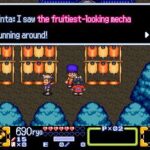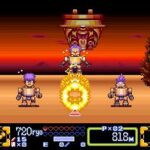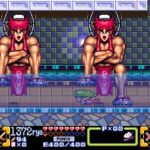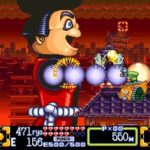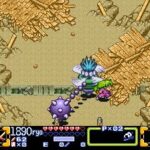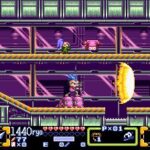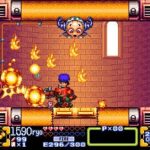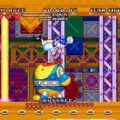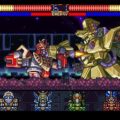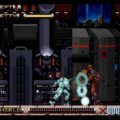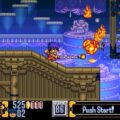Developer: KCET Publisher: Konami Released: 12/16/94 Genre: Action
Konami refusing to localize the Ganbare Goemon Super Famicom sequels has always hit pretty hard. Legend of the Mystical Ninja left an indelible impression on anyone fortunate enough to play it. But apparently that number was not high enough. Such is life but it does not mean I have to like it. Ganbare Goemon 2 continued the streak of excellence with a slightly different structure. Ganbare Goemon 3: Shishijūrokubē no Karakuri Manji Gatame goes even further, adapting an action RPG formula but still keeping everything that made it unique. It is also just as great as its predecessors and now finally accessible thanks to a fan translation.
It is just another day in Edo era Japan but things are about to get weird. The Wise Old Man has built a time machine to spy on the girls of the future. Unfortunately his lecherous ways get the best of him as the denizens of the future kidnap him. Now Goemon and company must find a way to time travel to save him and Japan from a tyrannical ruler bent on traveling to the past and taking over the world.
Ganbare Goemon 3 is both familiar and a departure for the series. This is the first in the series to have all four characters playable as Yae joins the party. Everyone has a signature weapon and a secondary, be it Goemon’s gold toss, Sasuke’s bombs or Yae’s bazooka. In addition you can find ninja magic but outside of two that are mandatory and given to you these are optional. New to the series are mechanical walkers that can be used in towns and the game’s action sequences. Walkers gain their own set of upgrades through the course of the game and whenever they are needed can be bought cheaply at the travel center or the game will provide one nearby.
Goemon 3 ditches the world map of the second game for a large interconnected world. It heavily resembles Zelda in this regard and goes a bit further with the comparison. Collecting four silver cats raises your life bar by one heart; one gold cat does similar. Some of character weapons echo Link’s equipment. Goemon’s chain pipe is also a hook shot, Sasuke’s bombs can blow up walls, and Yae’s mermaid form is like the Zora flippers. Despite that it very much is still its own game. Connecting the various areas into one map is a natural fit for the series reminiscent of the Famicom games. The world is vast with multiple towns and hidden secrets everywhere. They were a little too clever with some secrets but I digress. While I miss the various mini-games and such I think Konami have done a great job retaining the series’ unique flavor.
The action stages are everything you expect and more. You can switch characters at any time and must do so frequently to progress. This never feels like a gimmick as everyone’s tools are necessary. It is not explicit but the different stages focus mostly on a single character. While it is hard to avoid picking favorites (platforming as Sasuke and Yae is the easiest) no one gets left behind. Level design is spectacular and incredibly creative. The maps are daunting at first but shortcuts open up at a brisk pace for easy navigation. Speaking of pacing it is a little slower than in prior titles as these feel more like Zelda dungeons as you collect keys/cards and gain new powers along the way. I mean that in a good way. If Nintendo were to make another title in the style of Zelda 2 I imagine it would similar to this.
The series goofy humor is in every facet of the game. The laugh track debuts here and accompanies genuinely funny moments. The villains and their puns made me laugh plenty of times with their silliness as well. The game goes a long way toward further distinguishing Ebisumaru from Goemon with his abilities and items. As goofy as his hula hoop is it is a great platforming tool. And Goemon Impact once proves that it is a worthwhile addition to the series through great and challenging boss battles. I guess I should not be surprised at this point. I thought it would be a cheap gimmick in the second game and Konami proved me wrong. This is the second time they have done so; I guess I should have a little more faith.
Like previous titles Ganbare Goemon 3 falls on the easy side. Don’t let the limited initial life bar fool you; you can take a lot of punishment. If you do even a little exploration silver cats to raise your life bar are easy to find. Life restoring scrolls are common and you can buy food in any of the main towns. Gold is never a problem even toward the end when you must purchase a few story critical items. I even forgot that you have lives at one point. Outside of the rare chase sequence I can honestly say I never died. The game can be a little obtuse in providing guidance at times but the world is not so large that you will not stumble into the next point eventually. The median difficulty keeps the game accessible, allowing everyone to see its great content.
In Closing
Ganbare Goemon 3 is a great game and continues the series’ hit streak on the SNES. Konami rarely missed on the SNES and titles like this show why. It took over two decades for a fan translation but the wait was worth it.


